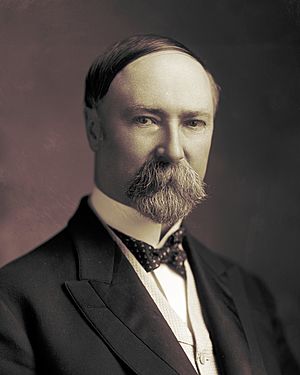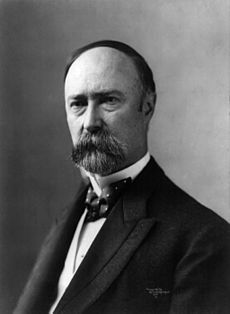Charles W. Fairbanks facts for kids
Quick facts for kids
Charles W. Fairbanks
|
|
|---|---|

Fairbanks, c. 1900s
|
|
| 26th Vice President of the United States | |
| In office March 4, 1905 – March 4, 1909 |
|
| President | Theodore Roosevelt |
| Preceded by | Theodore Roosevelt |
| Succeeded by | James S. Sherman |
| United States Senator from Indiana |
|
| In office March 4, 1897 – March 3, 1905 |
|
| Preceded by | Daniel W. Voorhees |
| Succeeded by | James A. Hemenway |
| Personal details | |
| Born |
Charles Warren Fairbanks
May 11, 1852 Unionville Center, Ohio, U.S. |
| Died | June 4, 1918 (aged 66) Indianapolis, Indiana, U.S. |
| Resting place | Crown Hill Cemetery |
| Political party | Republican |
| Spouse | |
| Children | 5 |
| Education | Ohio Wesleyan University (BA, MA) |
| Signature | |
Charles Warren Fairbanks (born May 11, 1852 – died June 4, 1918) was an American politician. He served as a Senator for Indiana from 1897 to 1905. After that, he became the 26th Vice President of the United States. He held this important job from 1905 to 1909. He was also chosen to run for Vice President again in the 1916 presidential election.
Fairbanks was born in Unionville Center, Ohio. After college, he moved to Indianapolis. He became a lawyer and worked with railroads. He gave an important speech at the 1896 Republican National Convention. The next year, he was elected to the Senate. As a Senator, he advised President William McKinley. He also helped solve a border problem with Alaska.
In 1904, Fairbanks was chosen to be President Theodore Roosevelt's running mate. They won the election. As Vice President, Fairbanks did not always agree with Roosevelt's new ideas. He tried to become president in 1908 but did not win. In 1916, he ran for Vice President again with Charles Evans Hughes. However, they lost to Woodrow Wilson and Thomas R. Marshall.
Contents
Early Life and Education
Charles Fairbanks was born in a log cabin in Ohio. His family's home was a safe place for runaway slaves. He went to local schools and worked on a farm. Later, he attended Ohio Wesleyan University. He graduated in 1872. At college, he met Cornelia Cole, who he later married. They were both editors of the school newspaper.
Starting His Career
Fairbanks's first job was reporting on political events for the Associated Press. This was in Pittsburgh, Pennsylvania. He studied law there. Then he moved to Cleveland, Ohio, and continued his law studies. In 1874, he became a lawyer in Ohio. Soon after, he moved to Indianapolis, Indiana. In 1875, he earned his Master of Arts degree from Ohio Wesleyan.
In Indiana, Fairbanks worked as a manager for a railroad company. He helped manage the company when it was having money problems. He also became a lawyer for a very rich railroad owner named Jay Gould.
Fairbanks started to get more involved in politics. He helped other politicians campaign. In 1893, he tried to become a Senator. But he did not win that time. In 1894, he worked hard to help Republicans win elections in Indiana. Because of his efforts, Republicans gained control of the state legislature. This meant a Republican would be chosen as Senator in 1897.
At the 1896 Republican National Convention, Fairbanks gave an important speech. This made him well-known. In January 1897, he was chosen as the Republican candidate for Senator. He officially became a Senator on March 4, 1897.
Serving as Senator
Fairbanks served eight years in the U.S. Senate. He was a key advisor to President William McKinley. This was during the Spanish–American War. He also led important committees, like the one on immigration. In 1898, he was part of a group that helped settle border issues with Canada. This included the Alaska boundary dispute.
Becoming Vice President (1905–1909)

In 1904, Fairbanks was elected Vice President with President Theodore Roosevelt. He served for four years, from 1905 to 1909. He was the first Vice President to serve a full term without having to cast any tie-breaking votes in the Senate.
Fairbanks was more traditional in his political views. President Roosevelt had many new, "progressive" ideas. Fairbanks often disagreed with these ideas. Because of this, Roosevelt did not give him a very big role in his government. Roosevelt decided not to run for president again in 1908. He strongly supported William Howard Taft to be the next president. Fairbanks also wanted to be president, but he did not win the Republican nomination. After his term, he went back to being a lawyer. In 1912, he supported Taft when Taft ran against Roosevelt.
After the Vice Presidency (1909–1918)
Running Again for Vice President
In 1916, Fairbanks helped create the Republican Party's plans for the country. He hoped to be nominated for president that year. But Charles Evans Hughes was chosen instead. Fairbanks was then selected to run as Vice President with Hughes. If they had won, Fairbanks would have been Vice President under two different presidents. Only two other people had done this before him.
However, Hughes and Fairbanks lost the election. It was a very close race against Woodrow Wilson and Thomas R. Marshall. After the election, Fairbanks returned to practicing law in Indianapolis. But his health soon began to get worse.
Death and What He Left Behind
Charles Fairbanks died on June 4, 1918, at age 66. He passed away from a kidney illness at his home. He was buried in Crown Hill Cemetery in Indianapolis.
Fairbanks received special honorary degrees from two universities. A special teaching position at Ohio Wesleyan University is named after him.
Several places are named after Charles Fairbanks. These include the city of Fairbanks, Alaska, and the area around it. There is also a school district in Ohio, and towns in Minnesota and Oregon named after him.
In 1966, a historical marker was placed in front of his home in Indianapolis. Another marker was put up in his birthplace in Ohio in 2009.
See also
 In Spanish: Charles W. Fairbanks para niños
In Spanish: Charles W. Fairbanks para niños




